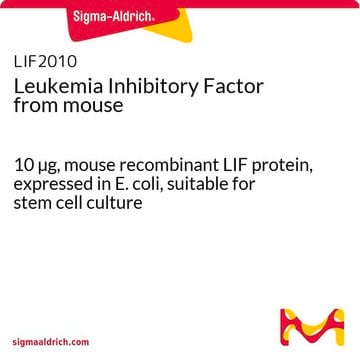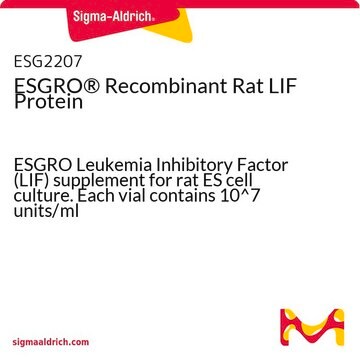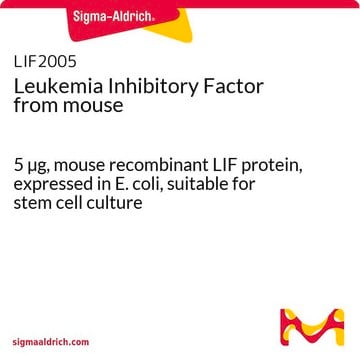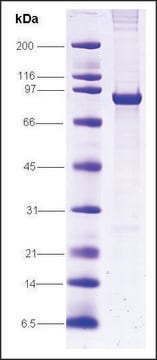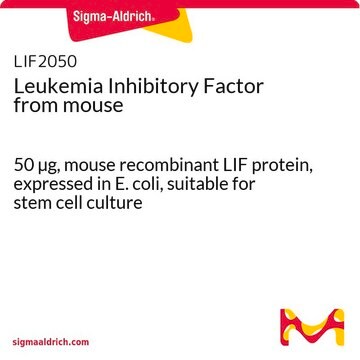LIF3010
Leukemia Inhibitory Factor Protein, Recombinant rat
Recombinant rat Leukemia Inhibitory Factor (LIF) protein is biologically active and suitable for cell culture applications.
Sinônimo(s):
LIF
About This Item
Produtos recomendados
fonte biológica
rat
Nível de qualidade
Ensaio
>85% (HPLC and SDS-PAGE)
forma
liquid
atividade específica
≥1 x 10(e8) U/mg
fabricante/nome comercial
Chemicon®
concentração
10 μg/mL
técnica(s)
cell culture | stem cell: suitable
Impurezas
<0.1 ng/μg Endotoxin (of LIF)
entrada
sample type: mouse embryonic stem cell(s)
sample type mesenchymal stem cell(s)
sample type hematopoietic stem cell(s)
sample type neural stem cell(s)
sample type induced pluripotent stem cell(s)
nº de adesão UniProt
Condições de expedição
dry ice
Descrição geral
Aplicação
M1 Bioassay
1.The M1 bioassay is performed using in vitro semi-solid agar cultures, which contain approximately 100 cells in 1 mL volumes of DME containing 20 % FCS in 0.3% agar.
2.Add 100 μL of sample or rtLIF (10(e4) units/mL in 5% FCS in isotonic saline) in two-fold serial dilutions in duplicate to 35 mm petri dishes.
3.Add 100 μL of 5% FCS in isotonic saline to two control slides.
4.Incubate at 37°C in fully humidified atmosphere of 10% CO2 in air for 7 days.
5.Score the number of colonies that show differentiation (note: 50 units is defined as the amount of activity which results in 50% of the colonies being differentiated).
Visit www.esgro-lif.com for additional information
Definição da unidade
forma física
Armazenamento e estabilidade
Nota de análise
Informações legais
Exoneração de responsabilidade
Código de classe de armazenamento
12 - Non Combustible Liquids
Classe de risco de água (WGK)
WGK 2
Certificados de análise (COA)
Busque Certificados de análise (COA) digitando o Número do Lote do produto. Os números de lote e remessa podem ser encontrados no rótulo de um produto após a palavra “Lot” ou “Batch”.
Já possui este produto?
Encontre a documentação dos produtos que você adquiriu recentemente na biblioteca de documentos.
Conteúdo relacionado
This article shows that a PES membrane containing Stericup Quick Release filter provides an alternative for the pluripotent expansion of embryonic stem cells.
Nossa equipe de cientistas tem experiência em todas as áreas de pesquisa, incluindo Life Sciences, ciência de materiais, síntese química, cromatografia, química analítica e muitas outras.
Entre em contato com a assistência técnica
